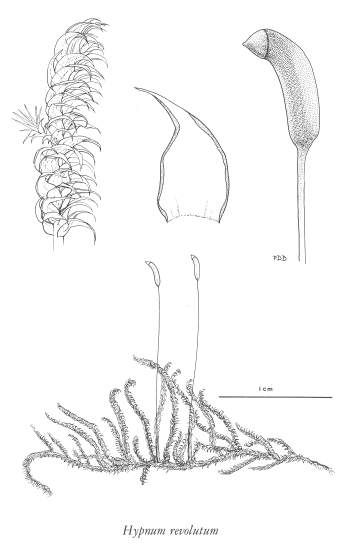Hypnum revolutum var. revolutum (Mitt.) Lindh.
moss
Hypnaceae
Species Account Author: Wilf Schofield
Extracted from Some Common Mosses of BC
Introduction to the Bryophytes of BC
moss
Hypnaceae
Species Account Author: Wilf Schofield
Extracted from Some Common Mosses of BC
Introduction to the Bryophytes of BC
Map
Distribution of Hypnum revolutum var. revolutum
Click here to view the full interactive map and legend
Species Information
Species description:
Species name describing the strongly recurved margins of the leaves.
Reproduction:
Sporophytes occasional to rare; the plants fragment readily when dry and the fragments probably serve in propagation. Sporophytes are red-brown when ripe; sporangia are inclined to suberect, cylindric and curved.
Distinguishing characteristics:
The strongly revolute leaf margins and the seeming absence of midribs, combined with the dry substratum and the frequent regular branching of the golden brownish-green plants are useful features.
Habit:
Golden green to brownish-green, creeping, often regularly branched mats usually loosely attached to substratum.
Similar Species:
H. cupressiforme and H. vaucheri grow in similar habitats and are often the same colour as H. revotutum. They, however, lack regular branching and also lack revolute leaf margins. Microscopically, they have a triangular area of small alar cells that separate them readily from H. revotutum. Drepanoc!adus uncinatus, of similar habitats, has pleated leaves with a midrib; the leaves are very strongly curved. H. recurvatum is much more slender and is usually firmly affixed to its rock substratum.
Illustration

If more than one illustration is available for a species (e.g., separate illustrations were provided for two subspecies) then links to the separate images will be provided below. Note that individual subspecies or varietal illustrations are not always available.
Illustration Source: Some Common Mosses of BC
Habitat and Range
Habitat
Usually on rock (especially in calcium-rich areas) but also terrestrial and on logs, occasionally ascending tree bases. Rare near the coast but frequent in the interior and in the northern third of the province. Range
World DistributionWidely distributed in the Northern Hemisphere in both boreal and arctic regions, but known also from Antarctica and New Zealand.
